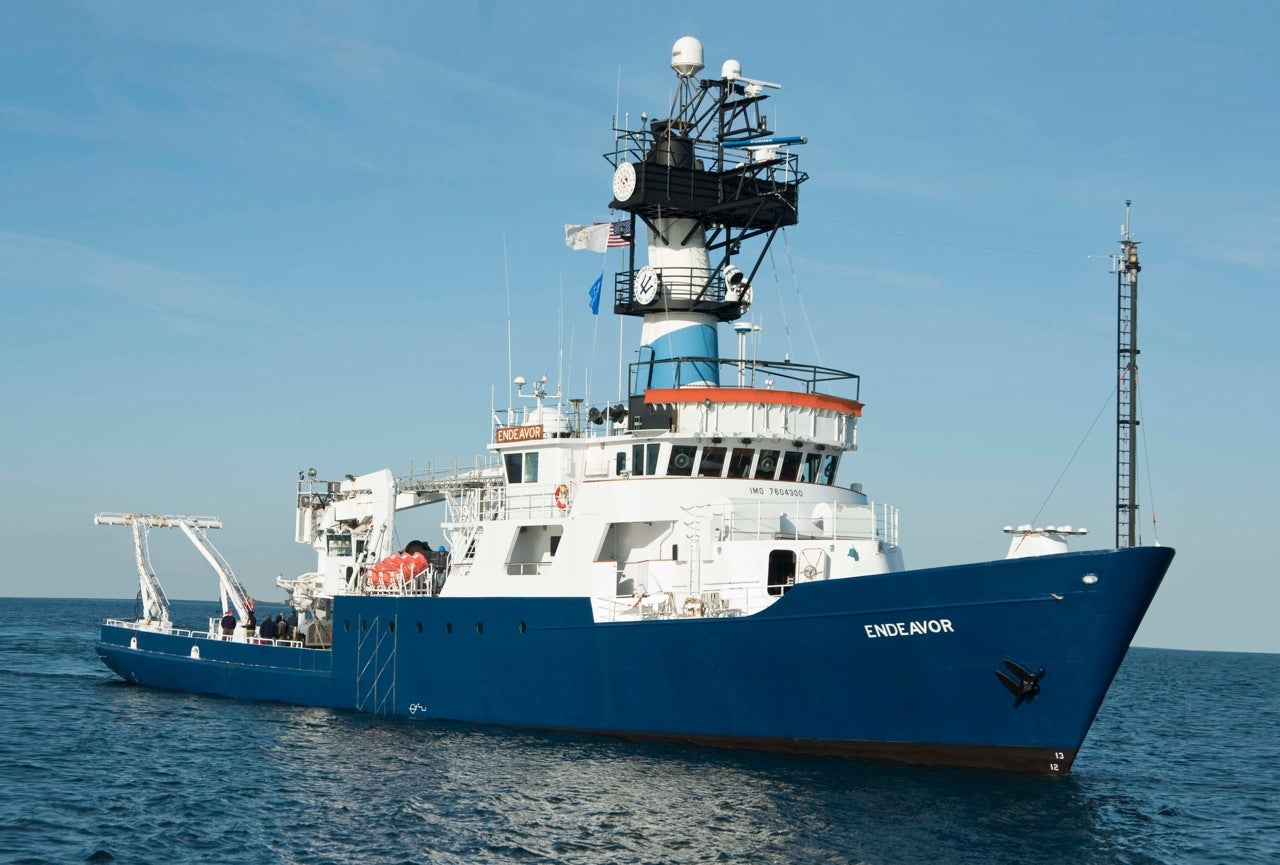We’ll start this (B)log with a quiz. Who has a home address in Narragansett but might be spending the winter in the warm waters of the Hawaiian Islands, the Caribbean, or the Gulf of Mexico? She has crossed the Atlantic as Rhode Islanders sometimes do, to visit the Azores. She has ventured north of here to the waters off Iceland and even into the Arctic Ocean. Sometimes she stays closer to home and goes out to Block Island or a little beyond there. All the time, she enjoys being on the water. Any ideas? She is the University of Rhode Island Graduate School of Oceanography (GSO)’s 185 foot research vessel, the R/V Endeavor (see photo to the right). She has many of the capabilities of a land-based GSO research lab, but she floats on the water and can move to anywhere that water goes. She is owned by the National Science Foundation (NSF) but is operated by GSO under the University-National Oceanographic Laboratory System (UNOLS).
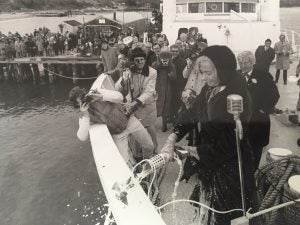
On December 11, 1976, with hundreds looking on, the new GSO research vessel, R/V Endeavor was christened by Nuala Pell, wife of Senator Claiborne Pell with the traditional bottle of champagne at the pier at GSO (see photo at left). Senator Pell was instrumental in bringing the ship to GSO.
Within days, the big story in all the New England newspapers was that on December 15, the ship the Argo Merchant, carrying 7,700,000 gallons of No. 6 fuel oil, ran aground off Nantucket Island in bad weather and broke up over the next week. The story soon hit national news because with all that oil spreading into the waters, it was one of the largest oil spills in US history (see photo below). The day after Christmas, the R/V Endeavor set sail for the site with scientists from GSO and Ocean Engineering on the first of four cruises to sample many parameters from currents to oil hydrocarbon to marine organisms. This was the first example of the value to GSO of the R/V Endeavor and the first test of her research capabilities.
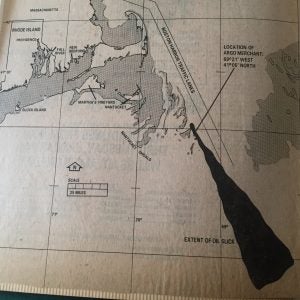
The R/V Endeavor is also an ambassador for the state, bringing a bit of Rhode Island to far flung places while fulfilling her mission for research, community service, and outreach. She has, over the past 42 years, been on over 600 cruises bringing scientists to research sites over most of the global ocean. And it’s not just GSO scientists that go out on the R/V Endeavor, scientists from all over the world book ship time. Sometimes those scientists fly or drive to RI and sometimes they meet the R/V Endeavor at another port of call. Selected Rhode Island K-12 teachers get to go out too, as part of the state-funded RI Endeavor Program’s Teacher-at-Sea Program, so they can experience ocean going research and bring it back to their classrooms. Last month the R/V Endeavor was on a 6-day cruise with a class of URI Honors undergraduates carrying out research on Right whales and on the zooplankton (microscopic animals) they eat, another opportunity of the RI Endeavor Program.
As said by GSO’s newest Biological Oceanography faculty member, Kelton McMahon, “Having a world-class oceanographic research vessel at GSO was a major selling point for me during my search for an institution to build and grow my lab. The ability to walk out of my office and onto such a vessel has opened new doors for my students and me to see how the theories we develop in lab translate to the real world at sea.”
And this from GSO Assistant Professor Dr. Jaime Palter who heads up the Ocean Circulation and Biogeochemistry Research Group at GSO “I see the ship as an important recruiting tool for faculty who want to observe the ocean. In a day and a half the Endeavor can leave the Bay Campus pier, cross the entire continental shelf and slope, and be sampling in the Gulf Stream. In fact, that’s what we did in a recent cruise to assess the role of the Gulf Stream in some major biogeochemical processes. In addition, with URI’s strength in telepresence, we also bring shipboard activities directly to classrooms. It was amazing to teach my undergraduate class in Kingston from the rainy deck of the Endeavor as we transited to the Gulf Stream.”
Have you ever been at the GSO pier when the R/V Endeavor embarked on a cruise? There is a flurry of activity and then, almost silently, she slips away from the pier. There is cool video (including some drone footage) of the Endeavor being loaded and heading off down Narragansett Bay at: https://techserv.gso.uri.edu/. At that site you can find out much more about this ship and her history. If you want to follow her cruise tracks in real time, go to the website https://techserv.gso.uri.edu/EndeavorNow.
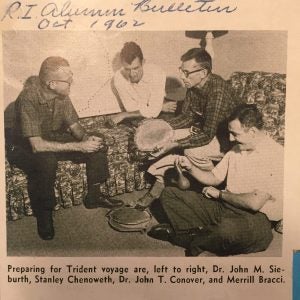
Before the R/V Endeavor, GSO’s research lab that floats was the R/V Trident. She was acquired in San Diego, California by GSO from the Army where she had been a maintenance and supply ship. Putting her to work right away, her first oceanographic voyage started September 15,1962 and was the 5,780 mile trip from San Diego, through the Panama Canal, to Narragansett during which four URI researchers carried out a range of measurements: Dr. John McN. Sieburth and Mr. Merrill Bracci studied how bacteria thrive in cold waters; Mr. Stan Chenoweth (MS ’63) took bottom sediment samples and water column phytoplankton samples; and Dr. John Conover was studying the seaweed Sargassum (see photo to left). Also on this cruise was the Dean-elect John Knauss and the new captain, Barnes Collinson, and each were bringing their car and household goods since they were moving to Narragansett.
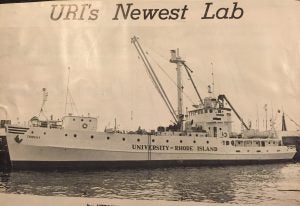
Soon after this, on November 3, at the State Pier in Galilee, the R/V Trident was officially christened by Mrs. Francis Horn, wife of the URI President. President Horn was a key advocate for bringing a ship to GSO. There was a huge crowd of 1,500 people, who were looking forward to tours of this first ever RI ocean research ship. The R/V Trident (see photo at right) had 2,000 ft of lab space and 90 ft of unrestricted space, the largest scientific laboratory area of any research vessel at the time. And soon after this ceremony, on November 11, the R/V Trident headed back out to sea to take bottom samples off the coast of New England, the first of many cruises that took her all over the world. You can read a fascinating first person account of the R/V Trident cruise to West Africa in the article “AFRAM 1963” by Don Gordon MS ’64 in “Aboard GSO” at https://web.uri.edu/wp-content/uploads/sites/916/Spring_11.pdf
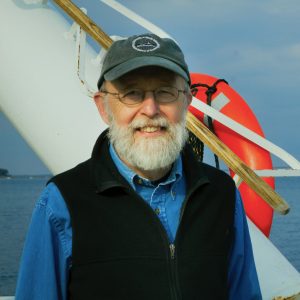
Now in 2018, the R/V Endeavor is over forty years old and still going strong, but that’s old age for a research vessel. So what is next? This past January, the East Coast Oceanographic Consortium was created by University of Rhode Island’s Graduate School of Oceanography with the Woods Hole Oceanographic Institution in Massachusetts and the University of New Hampshire and 11 associate members to run the R/V Endeavor for her remaining years and to put in a proposal for a new ship – a new research lab that floats – that the consortium would operate together. “The objective of the consortium is to enhance and promote research and education among its members,” says Corliss (see photo to left). “With decades of cumulative scientific experience and participation from dozens of the world’s preeminent oceanographers, the consortium has the expertise, resources and commitment to safely and effectively manage a new research vessel to address critical scientific questions worldwide.” The whole press release can be viewed at https://today.uri.edu/news/uri-creates-consortium-with-two-major-institutions-to-operate-endeavor-and-submit-proposal-for-new-research-vessel/ In today’s world, cooperation is the key to running a successful global research program and ship. But don’t worry, the plan is still to have her home port at GSO, so your quiz answer will be a new name, but she will be at the same home address.
Volume 1, Number 3
For further reading on these topics and to see more photos, check out:
For the early history of GSO and the R/V Trident, see the Providence Journal and Providence Evening Bulletin entries in the scrapbook: “History of GSO, Fishes, Fire, and South Ferry Church” assembled by Joyce A. Downey, Coordinator of Library Services, and located in the Pell Library.
For the early history of the R/V Endeavor and the Argo Merchant Oil Spill, see another scrapbook located in the Pell Library “Endeavor and the Argo Merchant, The Graduate School of Oceanography at Nantucket Shoals, 1976-1978” assembled by Eva J. Hoffman, GSO scientist.
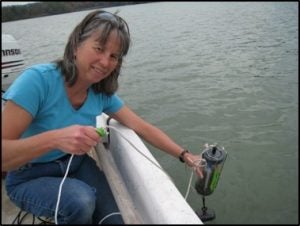
This blog post was written by Veronica M. Berounsky, GSO Science Correspondent and Coastal Ecologist. She first arrived at GSO in March of 1979 as a research lab tech. In 1990 she obtained her Ph.D., working on nitrification in Narragansett Bay with the late Scott W. Nixon. She continues to be fascinated by the ecology of coastal ecosystems every day. With this blog she hopes to increase your understanding of the activities and people of GSO and the Narragansett Bay Campus. Please email any comments to her at vmberounsky@uri.edu.
Or click here to see all previous Bay Campus (B)logs.

